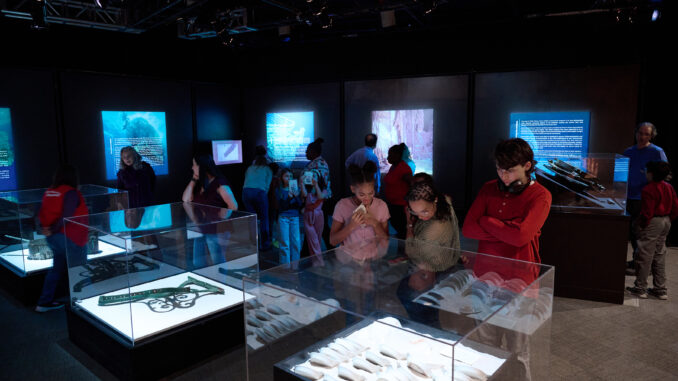
Zach Petroff | Opinions Editor
Without having to leave the city of Pittsburgh, history buffs have the opportunity to experience the historically tragic event of the Titanic.
Before entering the exhibit, patrons are given a passport of a passenger that took the trip on April 10, 1912. At the conclusion of the tour, it is revealed if the traveler survived the trip from Southampton, England, to New York City.
“We are excited to bring ‘Titanic: The Artifact Exhibition’ to Carnegie Science Center,” said director Jason Brown. “The exhibition weaves together the realms of history, archaeology and oceanography, perfectly aligning with our commitment to fostering scientific education and exploration.”
The Carnegie Science Center is hosting the traveling Titanic Artifact exhibit which features over 150 authentic artifacts, full-scale room-recreation and dozens of replicas of the British passenger liner, the RMS Titanic. The exhibit which travels the country arrived at the Carnegie Science center on Oct. 26 and will be available to the public until Dec. 26.
“A lot of people have a basic background of the Titanic from the movie and recent events,” said Norwell Webster, manager of gallery experience. “What this exhibit is able to do is bring the Titanic to life with real artifacts that actually have been brought up from underneath.”
The RMS Titanic, which was the largest ship at the time, struck an iceberg on April 15, 1912, during her maiden voyage to the United States. Of the 2,223 passengers and crew aboard, more than 1,500 people died.
It was the deadliest sinking of a single ship at the time.
The Titanic made headlines this summer when an underwater vessel, the titan submersible from OceanGate, imploded while touring the wreckage site and killed five people.
“There is just something about the Titanic that draws people in,” Webster said. “It’s a tragedy, but it is also fascinating to a lot of people.”
Katheryn Kirk and her son, Aiden, of Pittsburgh, said one of the reasons they visited the exhibit was because of her ‘fandom’ of James Cameron’s 1997 movie “Titanic.”
“I probably watched it 100 times growing up,” Kirk said. “It was such a big part of my childhood and ever since I’ve been fascinated with it.”
Her son Aiden has not watched the movie yet; they are waiting until he’s a little older, Kirk said.
Even with multiple viewings of the movie, there is still something new to learn at the exhibit.
“When people come in, they’re able to see the different historical pieces that we have been able to recover from the bottom ocean around the wreckage,” Webster said. “You can find plates, personal items that have been retrieved from suitcases that were freed into the ocean due to the events and even get a little insight into what we have learned from survivor accounts as far as their experience of that night.”
Along with the artifacts, patrons have an opportunity to see the living conditions of the exhibit and get a feel for what life was like on the Titanic for the first, second and third class passengers. Along with real-life replicas of the rooms onboard, first person accounts were displayed throughout the museum.
“This is a big piece of the Gilded Age. We get a glimpse into a time period right before the Great Depression so we’re able to see this rise in wealth and power in the world.”
“There was no moon, and I have never seen the stars shine brighter; they appear to stand out of the sky sparkling like diamonds. It was the kind of night that made one glad to be alive,” read the journal entry of first-class passenger Jack Thayer on the night before the carnage.
One of the more somber parts of the exhibit took patrons back to the night of the sinking. Chilling displays of deciphered morse code showed fateful messages along the walls.
The ending of the historical journey includes the name of every victim.
From artifacts to accounts, the exhibit brings history to life for all ages. The loss of human life left an impact on South Hills resident Marcia Morton.
“It doesn’t matter how long ago it was,” Morton said. “It’s just so sad to learn about all those people who died, and how cold it was. I could never imagine.”

